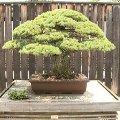If this tree could talk, it would have a lot to say. In its nearly 400 years of life it has seen more than one war.
"It is a survivor. It was actually in Hiroshima when the atomic bomb was dropped," said Jack Sustic, the Curator at the National Bonsai & Penjing Museum in Washington. He says the tree came to the U.S. in 1976, to celebrate the U.S. bi-centennial, as a gift of 53 bonsai from Japan, "This is a Japanese white pine; it was part of the original donation. It was in one family, the Yamaki family for 6 generations before they donated it. It was started as a Bonsai in 1625," Sustic said pointing to the tree. Sustic says the Yamaki family had a Bonsai nursery and this was one of their signature trees. Six generations of the family took care of the tree in Japan and so far four curators in the U.S. have cared for it.
"Mr. Yamaki the original donator, came 4 or 5 years after they donated it. It's an interesting story because he was here looking at the tree and he began to cry and the curator at the time got a little uneasy and a little nervous so he asked the translator to make sure everything was O.K., so the translator asked him, is everything O.K.? and he said yes the tree is happy here, that's why I am crying," he said. Sustic says taking care of the trees is an honor and a joy - but also a great responsibility. What would he do if something happened to them? "I don't even want to think about it. But I have a suitcase at home that is packed. If anything ever happens to this I don't think anybody would be able to find me," he said. The bonsai donation started this collection, the largest in North America, at the U.S. National Arboretum. The collection now has almost 300 trees, divided among three pavilions for the Japanese, Chinese and American bonsai.
"Bonsai literally means tree in a pot. But you can look around in the collection and see that is much more than just sticking a tree in a pot. It's an art also, is a living art," Sustic said. One of the most famous bonsai of the collection is this 57-year-old Juniper forest created by John Naka, considered the father of North American Bonsai. He planted one tree for every one of his grandchildren. "The work on the tree never ends because it is a living art. It's the pruning technique that keeps it small," Sustic said. The art of the Bonsai demands great care and patience, carried out here by a small staff and 15 volunteers. The trees continue growing, so they have to be trimmed once or twice a year, and re-potted every couple of years. Some of the trees are particularly sensitive, like this one.
"It doesn't like the oil from your fingers and it doesn't like to be rubbed or anything like that, so whenever that happen, the tips turn brown, so I have to go in and remove the brown," Sustic said. The Bonsai collection is priceless. Every tree is unique and the average age is around 100-years-old - which means several generations have cared for them. Bonsai trees bloom, give fruits and change colors in the fall. Sustic says he and his family eat apples from one of his 30 bonsai at home.
"One interesting aspect is that fruit and flowers will not reduce in size," Sustic said. From its beginnings in China more than 1,000 years ago, the art of the Bonsai was only a pastime of the elite for many centuries In the U.S., it has grown in popularity mostly due to the support of the National Bonsai Foundation. Johann Klodsen is the foundation's director, and like others close to the collection, she says there is more to the bonsai than simply what one sees. "Standing like in any work of art before a great piece of art, it becomes a conversation between the work of art and the individual and that conversation takes on a spiritual dimension," she said. "If you do Bonsai, it begins to change you as a person I believe. It makes you a better person. It teaches you patience and reverence. It certainly has made me a better person," she said.

